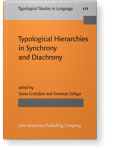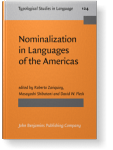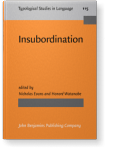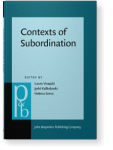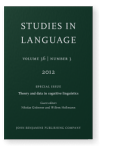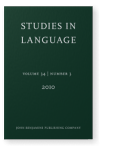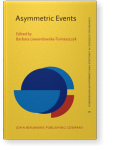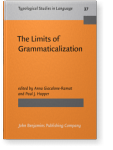Sonia Cristofaro
List of John Benjamins publications for which Sonia Cristofaro plays a role.
Book series
Title
Typological Hierarchies in Synchrony and Diachrony
Edited by Sonia Cristofaro and Fernando Zúñiga
[Typological Studies in Language, 121] 2018. vi, 434 pp.
Subjects Historical linguistics | Theoretical linguistics | Typology
2024 Diachronic pathways to case marking alignment and what they mean for the explanation of synchronic cross-linguistic patterns Journal of Historical Linguistics 14:1, pp. 142–177 | Article
Case marking alignment has been assumed to reflect principles of optimization: dedicated case marking is limited to arguments more in need of disambiguation, and semantically or pragmatically similar arguments are encoded by the same case forms. This view is based on the synchronic properties of… read more
2024 The diachronic emergence of alignment cross‑linguistically: Theoretical and empirical perspectives Journal of Historical Linguistics 14:1, pp. 58–65 | Introduction
The possible origins of the various alignment patterns attested in the world’s languages have been the object of sustained interest in both language typology and historical linguistics (see Dahl 2021a for a recent overview). What is meant here by alignment, in a maximally general sense, is any… read more
2019 Chapter 3. Nominalization in cross-linguistic diachronic perspective Nominalization in Languages of the Americas, Zariquiey, Roberto, Masayoshi Shibatani and David W. Fleck (eds.), pp. 169–194 | Chapter
While more and more data are now available on languages rich in nominalizations, such as those of Latin America, the literature on nominalization is mainly synchronically orientented. The paper discusses several pieces of diachronic evidence about the origins of nominalization cross-linguistically.… read more
2018 Synchronic vs. diachronic approaches to typological hierarchies Typological Hierarchies in Synchrony and Diachrony, Cristofaro, Sonia and Fernando Zúñiga (eds.), pp. 3–28 | Chapter
2016 Chapter 15. Routes to insubordination: A cross-linguistic perspective Insubordination, Evans, Nicholas and Honoré Watanabe (eds.), pp. 393–422 | Article
Cross-linguistic data suggest that we still know relatively little on the possible origins of insubordination, that is, what source constructions give rise to particular types of insubordinate clauses, through what mechanisms, and why. Insubordinate clauses can develop through a wider range of… read more
2014 Is there really a syntactic category of subordination? Contexts of Subordination: Cognitive, typological and discourse perspectives, Visapää, Laura, Jyrki Kalliokoski and Helena Sorva (eds.), pp. 73–91 | Article
While different criteria are used in the literature in order to define subordinate clauses, these clauses are generally assumed to form a syntactic category, in the sense of a syntactically defined class that is relevant to speakers of individual languages. Many phenomena that are usually regarded… read more
2014 Cognitive explanations, distributional evidence, and diachrony Theory and Data in Cognitive Linguistics, Gisborne, Nikolas and Willem B. Hollmann (eds.), pp. 185–210 | Article
Cognitively oriented approaches to the study of language standardly use synchronic distributional evidence to make assumptions both about the psychological mechanisms that lead speakers to create particular constructions, and about the components of a speaker’s mental representation of their… read more
2012 Cognitive explanations, distributional evidence, and diachrony Theory and data in cognitive linguistics, Gisborne, Nikolas and Willem B. Hollmann (eds.), pp. 645–670 | Article
Cognitively oriented approaches to the study of language standardly use synchronic distributional evidence to make assumptions both about the psychological mechanisms that lead speakers to create particular constructions, and about the components of a speaker’s mental representation of their… read more
2008 8. Asymmetric events, subordination, and grammatical categories Asymmetric Events, Lewandowska-Tomaszczyk, Barbara (ed.), pp. 151–172 | Article
The notion of asymmetric events plays a central role in many theories of subordination. Subordination has been associated with various types of event asymmetry, such as foreground-background, figure-ground, asserted vs. nonasserted information, and presence vs. absence of an autonomous cognitive… read more
2007 Relativization strategies in the languages of Europe Europe and the Mediterranean as Linguistic Areas: Convergencies from a historical and typological perspective, Ramat, Paolo and Elisa Roma (eds.), pp. 63–93 | Article
This paper examines the relativization patterns found in twenty-six languages of Europe, focusing on the strategies used to encode the relativized item. We provide a critical overview of extant classifications of these strategies, and discuss the distribution of these strategies across different… read more
1998 Grammaticalization and clause linkage strategies: a typological approach with particular reference to Ancient Greek The Limits of Grammaticalization, Giacalone Ramat, Anna and Paul J. Hopper (eds.), pp. 59–88 | Article

